By Alibaba Cloud Data Intelligence Team
Liu Lei from Alibaba's Machine Intelligence Technology Laboratory gave a speech titled "High-Accuracy Population-based Image Search" on the 2018 Apsara technology platform. He introduced Image Search in four areas, including basic concepts, technical architecture and advantages, application scenarios and cases, and commercial use and price.
Established in 2018, the Machine Intelligence Technology Laboratory comprises of a group of outstanding scientists and engineers, with research centers located in Hangzhou, Beijing, Seattle, Silicon Valley, and Singapore. Machine Intelligence Technology Laboratory is Alibaba's core team responsible for the research and development of artificial intelligence technologies. Relying on Alibaba's valuable massive data and machine learning/deep learning technologies, the lab has developed image recognition, speech interaction, natural language understanding, intelligent decision-making, and other core artificial intelligence technologies. It fully empowers Alibaba Group's important businesses such as e-commerce, finance, logistics, social interaction, and entertainment, and also provides outputs to ecosystem partners to jointly build a smart future.

Image Search is an intelligent image search product that enables search by image using image recognition and search functions, based on deep learning and large-scale machine learning technologies. It mainly consists of search by same image and similar image. Based on image recognition technologies, Image Search combines the application and business scenarios in different industries to help users research data by same image and similar image. Image Search can be used in a wide range of business areas because it is available for all users with image databases.
Image Search has experienced three main development phases. In August 2014, we launched the image search technology on Taobao Pailitao, allowing users to search commodities by photo for the first time. In February 2017, we started to share the image search technology with our business partners. In 2018, we began to empower the image search technology widely on Alibaba Cloud, and launched this technology on Alibaba Cloud and worldwide in July.
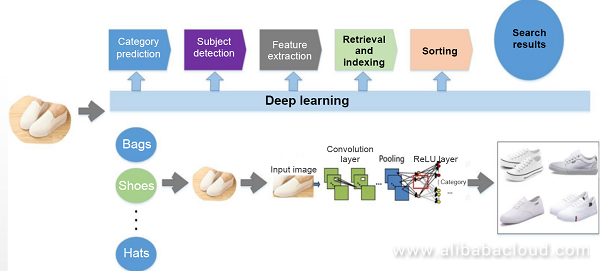
The image search technology mainly involves five algorithm modules:
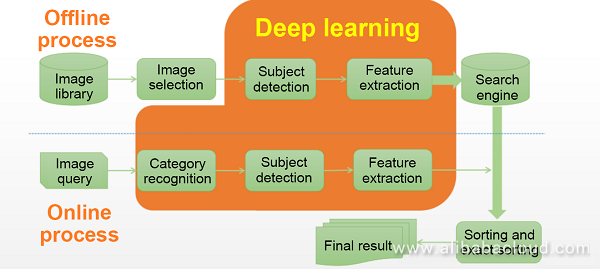
In the offline process, the service selects an image from the image library, detects its subject, and then extracts its features to establish an image retrieval engine. In the online process, the service predicts and determines the category of the image you queried, detects its subject, and extracts features. It finally outputs the result after retrieval and sorting.
Deep learning is based on industry-leading deep learning algorithms and massive data, featuring good effect, high accuracy, and strong robustness. We have also independently developed the quick indexing technology that supports ten billions of images and instant response within milliseconds. All products are reliable, stable, and effective as they are verified on Alibaba's e-commerce platforms. Furthermore, we have customized some functions to make Image Search fully available for all business scenarios. For example, we have integrated Alibaba Cloud computing capabilities and MIT visual AI capabilities.
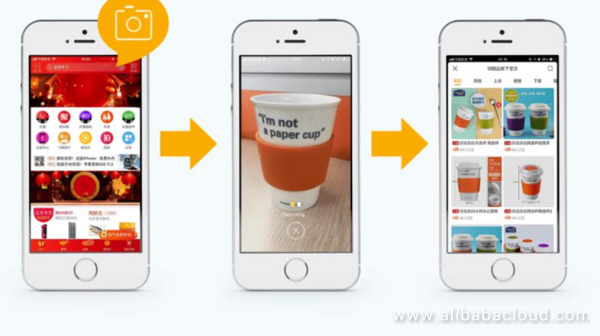
Users can simply take or upload photos to search items by image. This saves tedious text descriptions and simplifies the commodity search process, greatly improving users' shopping experience. Sellers can also recommend their products to users more conveniently.
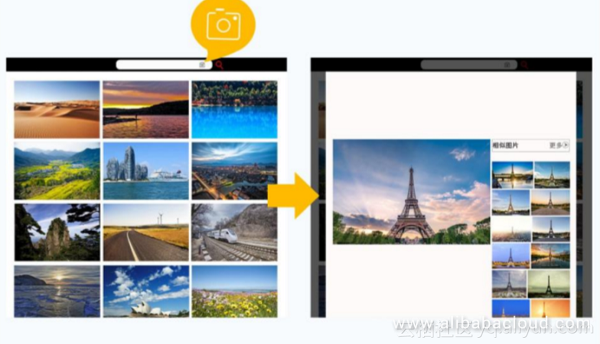
Image sharing and social interaction websites often provide plenty of images for users. Image Search quickly builds a cloud search engine with ten billions of images for search by image, improving user experience.
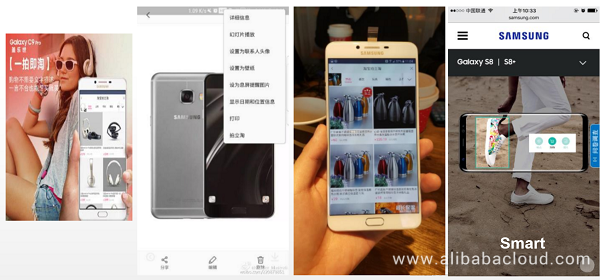
An image search technology was deployed in the operating system of Samsung Galaxy S8 to search related commodities on Taobao by photo in the album. This improves user experience in shopping search.

Image Search was launched commercially at both Chinese sites and international sites on July 11 and is well received by customers. The two billing methods available at present are prepaid resource package and post-payment. You can purchase a prepaid resource package for Image Search by calendar month/year. After the package is purchased, the call count is deducted from the quota provided in the resource package. After the quota is used up, the billing method is switched to post-payment by default. A tiered discount policy is provided based on the call quota and subscription period in the prepaid resource package. The larger the call quota is or the longer the subscription period (such as yearly payment) is, the lower the unit price gets. After the quota in the existing prepaid resource package is used up, the billing method is switched to post-payment by default, and then the service is billed by the call count.
To learn more about Alibaba Cloud Image Search, visit www.alibabacloud.com/product/imagesearch

2,593 posts | 791 followers
FollowAlibaba Cloud Community - March 21, 2022
ApsaraDB - May 19, 2025
Proxima - April 30, 2021
Alibaba Cloud Community - November 7, 2025
Alibaba Cloud Community - January 17, 2022
Alibaba Cloud Community - April 22, 2025

2,593 posts | 791 followers
Follow Image Search
Image Search
An intelligent image search service with product search and generic search features to help users resolve image search requests.
Learn More MaxCompute
MaxCompute
Conduct large-scale data warehousing with MaxCompute
Learn More E-MapReduce Service
E-MapReduce Service
A Big Data service that uses Apache Hadoop and Spark to process and analyze data
Learn MoreMore Posts by Alibaba Clouder
Raja_KT February 19, 2019 at 6:05 am
In the "Technical Process of Image Search", the online, offline choice is interesting.